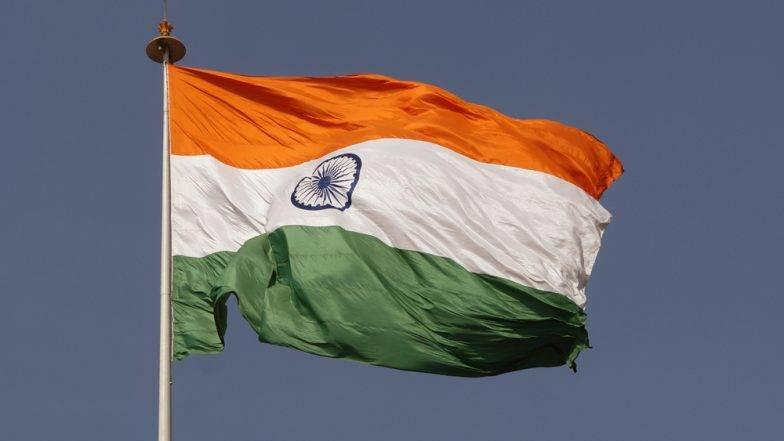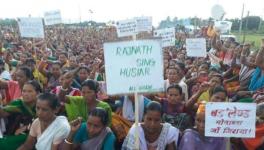Hindutva Icon Syama Prasad Mookerjee Had Nothing But Contempt For Tricolour

Image Coutesy: Latest LY
This Republic Day, the irony to see in power those very forces that had opposed in the past and seek to destroy today what the Republic stands for - whether it is secularism, reservations, protection to SCs/STs from atrocities, the Hindi question, or the national flag – behave like the personification of patriotism, could not be starker.
To give themselves and saffron politics some historical legitimacy, there are two basic methods of manipulation the BJP-RSS propaganda engages in when it comes to historical figures. The first is the appropriation of individuals so as to either portray them as more in line with saffron thought, or to show them as allies – such as has been done with Bhagat Singh, Vivekananda, Madan Mohan Malaviya, GB Pant and Sardar Patel. The second kind is historical exaggeration, in which saffron leaders are portrayed in much better light than the actual fact, as major nationalists with large public support – as has been done with VD Savarkar, KB Hedgewar, MS Golwalkar, AB Vajpayee, DD Upadhyaya, and Syama Prasad Mookerjee.
On one hand, the BJP government and the Rashtriya Swayamsevak Sangh (RSS) are saffronising the idea of India, manufacturing national icons and attempting to impose social conservatism and Hindu extremism as the basic tenets of “love for the nation”. At the same time, they are also branding and witch-hunting those who oppose these moves as “anti-national”, “Urban Naxal” or “secessionist”.
Also Read: https://www.newsclick.in/stooges-over-scholars-sanghs-latest-attacks-academic-institutions
The anti-India tendencies of the saffron forces are in the process erased. The Sangh and the Hindu Mahasabha have a history of having rejected the very tricolour flag they are brandishing today at secular opponents. This is best demonstrated in the case of Syama Prasad Mookerjee, a Hindu Mahasabha leader from Bengal with close ties to the RSS, who was a minister in the interim government from 1947-50, and was one of the founders of the Bharatiya Jana Sangh.
Sangh’s Continuous Attempts to Undermine the Tricolour before Independence
Mookerjee, in an article titled ‘Partition Not Inevitable’, published in the RSS mouthpiece Organiser, on July 17, 1947 – discredits the tricolour and makes a case for the bhagwa (saffron) flag as representing an “unbroken 5,000 years history”, as the most complete representation of the nation, of its traditions, culture and civilisation, and states that “there is no need for the flag to be acceptable to all communities”.
The Sangh paper Organiser carried several pieces opposing the tricolour, in the run up to August 15, 1947 – from rejecting the use of the green colour, to declaring that:
“...a flag having the Bhagwa colour is the only one which should and can be the national Flag in Hindusthan. The people who have come to power by the kick of fate may give in our hands the tri-colour but it will never be respected and owned by Hindus.” (Mystery Behind The Bhagwa Dhwaj, Organiser August 14, 1947)
It also emerges that Mookerjee, even after independence and the adoption of the tricolour by the government and the nation, was flying the saffron flag from his ministerial bungalow rather than the tricolour.
A letter addressed to Mookerjee, who was then the Union Minister for Industry and Supplies, dated September 28, 1947, written by the then Prime Minister of India, Jawaharlal Nehru states (reproduced in full):
“My dear Dr. Mookerjee,
I have been wanting to see you; but there has been so much work to do that it was difficult to find the time to go anywhere. I hope you are better now.
I have read the following AP message from Kolhapur dated September 25:
Mr L.B. Bhopatkar, President of the All India Hindu Mahasabha, addressing a press conference here this morning said that Dr. Syama Prasad Mookerjee was in the Indian Cabinet as a representative of the Hindu Mahasabha and would stay there as long as long as the Mahasabha asked him to remain. His allegiance was to the Hindu Mahasabha and Bhagwa Jhanda that had been made clear even before his joining the Cabinet. It was the Bhagwa Jhanda which was flying over Dr. Mookerjee’s house in Delhi and not the Tri-colour.
This raises a new point which, I think, should be cleared up. When I invited you to join the Cabinet you made it clear to me that you would continue to remain in the Hindu Mahasabha. Further, you told me that you had telephoned to Mr. Savarkar and Mr. Bhopatkar on the subject of your joining the Cabinet. I replied that of course you could remain in the Hindu Mahasabha. So far as I remember there was no mention of your joining the Cabinet as a representative of the Hindu Mahasabha owing allegiance to that Sabha’s mandate. Certainly, this was not made clear to me in any way and if this had been mentioned, it would have created difficulties. I did not even know that the Bhagwa Jhanda was flying over your house - instead of the National Flag. It seems to me very odd that a Minister should fly any flag but the National Flag.
I shall be very grateful if you will let me know what the facts are.
Yours sincerely,
Jawaharlal Nehru”
(September 1947, Selected Works of Jawaharlal Nehru, Vol 4, p. 506-7)
S. Gopal’s annotation in the Selected Works edition of the letter by Nehru regarding the use of two flags by Syama Prasad Mookerjee mentions his reply dated September 30,1947. This reply acknowledged the use of the Bhagwa Jhanda from “time to time”, and that the national flag flew from August 15, 1947 onwards. It also showed his acceptance of the fact that despite being a member of the Mahasabha, he was not in the cabinet as its representative.
(September 30, 1947, Selected Works of Jawaharlal Nehru, Vol. 4, p. 506-7)
Mookerjee’s Loyalty to his Party and Clique
Further, it was also made clear that his loyalties were not to the nation or the Indian government as a cabinet minister, but to his party and clique. Nehru had first asked Mookerjee about the national flag and his ties to the Mahasabha in September, 1947. According to popular history-telling, including textbooks and even Wikipedia, Mookerjee was a moderate who allegedly distanced himself from the Mahasabha after the Gandhi murder, and was a free agent till he started the Jan Sangh. This was simply not the case. The subsequent correspondences between Mookerjee and Nehru after the Gandhi murder, show a very different picture.
Jawaharlal Nehru had written to Mookerjee on several occasions, highlighting his alarm at the RSS and Hindu Mahasabha activities which involved undermining law and order, collecting arms, attacking villages and individuals, as well as delegitimising the government on communal grounds and demanding the hanging of Patel, Nehru and Maulana Azad. The responses were not helpful. After the assassination of Gandhi and the banning of private armies, Nehru appealed once more to Mookerjee to disown the politics of communal hatred.
Also Read: https://www.newsclick.in/fact-check-rss-had-no-role-indias-freedom-struggle
Nehru’s correspondence with Mookerjee indicate that he was genuinely concerned about the question of divided loyalties, and not simply for how it looked in the eyes of the public. Going by right-wing logic, two flags implied divided or traitorous loyalties. For the Hindu Mahasabha and the RSS (the very people who set up the Jan Sangh and then the BJP), their own history of collaboration with the British and antagonism with the national movement is rather telling – from Savarkar’s letters pleading for mercy, to opposing the Quit India Movement, to the Mahasabha-Muslim League alliance ministries during the Second World War, to Mookerjee’s hypocrisies during the Bengal famine, to being a major perpetrator of communal hatred. The Hindu Mahasabha had the same bhagwa flag as the RSS, and their allegiance to that flag proves their loyalty to narrow ideology.
Sangh Brigade’s Relation with the Tricolour in Recent Times
Coming to more recent times, it is worth noting that the RSS installed the tricolour in its offices very late, and had unfurled the tricolour first only in 2002 – after 52 years. The backdrop is rather clear: the RSS had in 2001, in fact, filed an FIR on three persons for hoisting the tricolour at the RSS headquarters – which led to a public outcry, and questions as to why it opposed the act.
The BJP, Viswa Hindu Parishad (VHP) and RSS today, owing utmost allegiance to the destructive communal politics of the 1930s, 40s and 90s, do not have the moral right to cause social disarray, reinforce rigid patriarchy, engage in caste discrimination and violent religious polarisation under the garb of patriotism, hiding behind our National Flag. The men of the “bhagwa” kind have garlanded lynching masterminds (Jayant Sinha), voluntarily defended rapists (Kathua, Unnao), destroyed the economy and ruined thousands of families (minorities, Kashmiris, tribals, and Dalits). After the Asaram and the Gurmeet Ram Rahim cases, the All India Akhara Parishad brought out a list of “fake babas”, which included the President of the All India Hindu Mahasabha, Swami Chakrapani Maharaj.
The historical evidence overwhelmingly highlights the role the Hindu right played immediately post-Independence as a destabilising force. Syama Prasad Mookerjee had nothing but contempt for the tricolour and the Republic – and his ideological descendants are no different.
Read More: https://www.newsclick.in/india/why-rss-afraid-words
Saib Bilaval is a PhD scholar in Modern and Contemporary History at Centre for Historical Studies, Jawaharlal Nehru University, Delhi.
Get the latest reports & analysis with people's perspective on Protests, movements & deep analytical videos, discussions of the current affairs in your Telegram app. Subscribe to NewsClick's Telegram channel & get Real-Time updates on stories, as they get published on our website.























